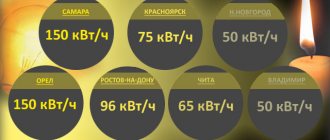Home/Heating rules/Formation of tariffs in 2020
Tariffs for thermal energy are constantly rising. Living in an apartment building with central heating, you have to pay regardless of your needs. A stunning new feature in 2020 was the charging of heating fees in the summer. To understand the essence of setting heating tariffs in 2020, you should familiarize yourself with the regulatory documents. Knowing some starting points, you can draw the right conclusions and take care of saving heat
Regulations
In 2010, a law was passed that regulates all heat issues. It’s called “On Heat Supply” (07/27/2010). The main points of this document are:
Attention! If you have any questions, you can chat for free with a lawyer at the bottom of the screen or call Moscow; Saint Petersburg; Free call for all of Russia.
- basic concepts;
- distribution of responsibilities of government bodies;
- government approach to pricing;
- relations between heat suppliers and customers;
- work on the quality of heat supply;
- price zones and their features;
- self-governing enterprises;
- rights to heat supply facilities.
Ordinary consumers are concerned only with the first six points. The structure that controls the heat supply is the Federal State Energy Supervision Authority. Antimonopoly control is assigned to the Antimonopoly Committee. The first authority in which an ordinary consumer can resolve heat-related issues of interest to him is the local authorities of administrative units.
Attention
Article 7 of the above document talks about the main approaches to setting prices and tariffs for heating in 2020. The main directions are accessibility for citizens of the state, feasibility from an economic point of view, stability. Part 6 is especially important in this article. It talks about the availability to the population of information related to heat pricing.
Many questions related to the formation of heating tariffs in 2020 are answered by Article 8. It discusses the types of payments that apply to ordinary consumers. Among them:
- tariffs for substances used for heat transfer;
- water heating fee;
- heat transportation services;
- maintaining thermal power in working condition during non-working periods.
The regulation of heat supply tariffs is based on the economic justification of costs, indexation, and ensuring profitability.
The second document relating to heat is the Federal Law of November 23, 2009 No. 261-F3 “On energy saving and increasing energy efficiency and on introducing amendments to certain legislative acts of the Russian Federation.” This law mainly concerns consumers in two chapters:
- Chapter 2 describes the powers of state authorities and local governments in the field of heat supply.
- Chapter 3 describes regulations, efficiency and heat metering.
How to calculate housing and communal services tariffs
Accordingly, Russians’ expenses for utility bills are growing rapidly. Therefore, the attitude of our citizens towards payment calculations for utility services is becoming more serious. 41 kopecks per cubic meter. I don’t understand the following: why am I being charged according to the tariff established for houses without a meter? And should housing and communal services still check radiators? Ministry of Housing and Communal Services. - regarding the size of established tariffs, disclosure of information by regulated organizations and other issues of state regulation, control (supervision) in the field of regulated prices (tariffs), the Government of the Russian Federation has determined that the explanation of the above is within the competence of the Ministry of Construction and Housing -municipal services of the Russian Federation (Ministry of Construction of Russia). We wish you good housing and communal services tariffs! There are many debtors in my house, although everyone wants a repaired roof, but does not consider it necessary to pay. It turns out interesting. What is included in utilities and how housing and communal services tariffs are formed. Examples of formulas for calculating the cost of housing and communal services. How are general house needs calculated? The calculated payment does not coincide with the one presented for payment. Tariffs Activities Government services Internet reception Question - Answer. Open government Open data Regions Vacancies Public procurement. This tariff is calculated taking into account the unit of measurement sq.m. The calculation is carried out according to a single approved tariff. Housing and communal services services are charged based on the square meters of the premises. Calculation of utility bills: tariffs, benefits, subsidies. Payment for housing and communal services. Payment for utilities is payment received from the consumer for water, gas, electricity, heating and other housing and communal services. The question of how to calculate utility bills is especially relevant in our time. If a citizen has any questions regarding how the amount of payment for housing and communal services was calculated, or needed advice on tariffs, he should contact the company. Payment for utility services is obtained by multiplying the housing and communal services tariff by the volume of resource used. In residential buildings with a large number of apartments, payment for sewerage is not calculated for each apartment, but based on the results of the general house. It tells us who sets housing and communal services tariffs and their increase, what inter-rate coefficients are and how indexation, examination and regulation of prices and their growth in heat and electricity in Russia. And also how to calculate their cost. What fees and charges include tariffs for utility services. In addition to housing and communal services, homeowners are charged a monthly fee for maintaining the house in proper condition, minor repairs to the building and communication systems. Check whether your rent is calculated correctly. The largest regions of the Russian Federation. Interactive service. — Tariffs for housing and communal services — Housing and communal services — Tariffs for housing and communal services — Housing and communal services — Articles and research. Utility payments calculator - calculating rent - checking the accuracy of invoices and utility tariffs for any locality in Russia Calculator How utility tariffs will increase in the Ivanovo region from July 1. Then, we consider the second component of the payment for heating, heating provided for general house needs, which in this case is calculated using two formulas 14 and 10. Due to the increase in housing and communal services tariffs, weekly inflation in Russia accelerated to 0.4. Since January 2020, the Decree of the Government of the Russian Federation has gained legal force, which provides for an increasing coefficient on housing and communal services tariffs if there are no meters. It is easy to calculate that the benefit for the year will be over 26 thousand rubles. How to find out the debt for housing and communal services? The question is almost idiotic. An apartment cannot have debt for housing and utilities. Thus, the cost of a utility service (calculated as the product of the tariff by the volume) is equal to the cost of the utility resource 07/05/2020 | Myths of housing and communal services: What area is used when calculating the cost of maintenance? From the above norm, it is concluded that when calculating the fee for housing maintenance, the tariff He correctly understood the Government Resolution, which clearly states how to calculate. We calculate the rent article, housing and communal services Where is This House.
We recommend reading: What does a speech therapist's vacation at a psychiatric hospital in the north consist of?
Tariffs for housing and communal services. In addition, information on housing and communal services tariffs can be found in the Housing Code or Government Decree. After clicking the “Calculate” button, the utility payment calculator will calculate the amount of payment for utility services in the volumes of December of the previous calendar year using the tariffs of the period under review. Every citizen has the right to independently check housing and communal services tariffs by raising the relevant regulatory documents. If he does not agree with how heating in the apartment is calculated, then he can write a statement to the Criminal Code. Such a jump in the cost of the tariff schedule is significantly lower than previously planned indicators. Video: Housing and communal services tariffs - who sets them, why they are growing and what to do? General tariff. Meter readings Who do you think is to blame for water supply interruptions in Saratov? Housing and communal services payment calculator. You can enter the details of your house and apartment, the number of residents and find out whether you are being charged for utilities correctly. Then you need to calculate the payment for heating using the following formula. Taking into account the constantly increasing tariffs for housing and communal services for heating, the question of reducing these costs is becoming more relevant every year . To calculate the cost of utilities or find information about their prices, you should open the online resource “housing and communal services.ukr/tariffs”. How to calculate if there is no meter? For homeowners' associations, as well as owners of private buildings, the tariff for housing and communal services is equal to the tariff of the supplier who supplies these services to consumers. Economy Finance Purchases Consumer market Prices and tariffs Property, land resources Urban planning Housing and communal services State programs of the Tyumen region Transport and roadsHow much do we pay for housing and communal services? On this issue, the Ministry of Housing and Communal Services and Energy of the Republic of Sakha (Yakutia) explains that the calculation of utility services when tariffs change is carried out in an automated information system, which is configured. Those who believe that when tariffs for housing and communal services are mistakenly believe. Most of us, having received a receipt for payment of utility services, have difficulty understanding these incomprehensible things. Having set out to find the tariff for heat and housing and communal services in different cities of the country, I found a wonderful website. Why do you need a housing and communal services payment calculator? The service takes into account utility tariffs of the Moscow region in 2020, as well as the volume of consumption of services. The heating tariff is approved individually for each region by local authorities. We are talking about the cost of 1 Gcal for heating. Accounting for housing and communal services determines the use of distributor readings in the calculation process.
Innovations
On July 19, 2020, a number of amendments were adopted to the law “On Heat Supply”. The main purpose of these changes is the transition from state management to negotiated prices. What exactly has changed in the legislation?
| Article | Old version | New option |
| Art.2 p10 | The program of investment projects of organizations involved in heat supply involves connecting consumers to the heat supply system. | The program of investment projects of organizations involved in heat supply involves connecting consumers to the heat supply system. This program is not being developed in price zones. |
| Art. 2p18a | It is permissible to set a price by agreement of the parties . | The price is set strictly as a result of the agreement of the parties, but cannot exceed the maximum permissible level |
| Art. 2p18b | The process of transferring thermal energy is regulated by the state | The process of transferring thermal energy is regulated by the state, but in some cases the price is acceptable by agreement of the parties |
| Article 15ch9.3 | Management organizations that receive heat for public services are required to pay fees on time, otherwise they will be charged penalties. | Management organizations that receive heat under a heat supply agreement are required to pay fees on time, otherwise they will be charged penalties. |
Everyone is equal, but some are more equal
For individual entrepreneurs in Tatarstan, electricity tariffs will increase by at least 10%. For the second year now, the main increase in electricity tariffs has been due to rising prices on the wholesale market. Electricity is purchased by suppliers of last resort and other energy sales companies - participants in the wholesale market for subsequent resale to end consumers or sales companies operating in the retail market. For example, on the territory of Tatarstan such companies are Alternative Sales Company LLC (the company has the same director as Tatenergosbyt), MagnitEnergo LLC, Lukoil-Energoservice LLC, RN-Energo LLC and others.
In our opinion, it is worthwhile to dwell in a little more detail on the situation with the increase in transmission tariffs. For reference: the main volume of electricity transportation in Tatarstan is carried out through the networks of OJSC “Grid Company” and then to some consumers through the networks of relatively small grid companies, the so-called territorial grid companies. At the same time, tariffs for transmission services are established for them. And here interesting things are discovered.
Thus, OJSC “Grid Company” of the Republic of Tatarstan this year was limited in the growth of tariffs. Its unified boiler tariffs for transmission services increased from 0.28 to 3.47% (depending on the voltage level), which cannot be said about other territorial network organizations operating in the territory of the Republic of Tatarstan. For example, at Kazan Energy LLC, the tariff for transmission services doubled compared to last year to 508.4 rubles per thousand kWh and one and a half times, to 603.9 rubles, respectively. For Kamaz-Energo LLC it increased by 9.4%, for Energotransit LLC - by 31%. Apparently, these companies are not subject to the requirement to limit the growth of tariffs for transmission services.
Who sets heating tariffs in 2020?
Article 11 of the Law “On Heat Supply” states that prices for heat and its transmission can be set by the regulatory body (clause 1). In this case, single-rate and two-rate tariffs are applied. Prices are subject to change. They depend on the type of heat source and the distance over which the thermal energy is transferred. Price changes are also influenced by other parameters, which are described in the document called “Basics of pricing in the heat supply sector.”
Article 15 of this law states that heat consumers purchase it from the heat supply organization on the basis of a bilateral agreement. According to Article 2, the price for consumed heat is set by agreement of the parties, but it should not exceed the maximum permissible. In other words, the state sets only minimum and maximum price limits (Article 8, paragraph 1). Otherwise, the cost of the services provided depends on the supplier. The heat energy supplier includes all costs plus estimated profit in its price. This is mentioned in Article 7.
The housing question - is there a limit to the ever-increasing prices for housing and communal services?
It is worth remembering that if the price of one resource has increased, then an inevitable decrease in another must follow. The government has the right to punish the leadership of the region in which the permissible index is exceeded. In Russia, the maximum allowable increase is allowed in the Kamchatka Territory and Yakutia - at approximately 6.7% per year, and the smallest - 3.2% - in North Ossetia.
The authorities of all regions of Russia, on the basis of Decree No. 848 PP dated December 13, 2020, fixed the increase in tariffs for housing and communal services from July 1, 2020. Since the law allows you to increase tariff prices only once a year, you will not see any more changes in the utility bills you receive this year.
Why do I pay for heating in summer?
According to the Law “On the Protection of Consumer Rights”, people are obliged to pay only for the service actually rendered. Why do heat supply organizations in 2020 charge for heating in the summer, because the radiators are cold? This question is fully answered by clause 1.7, clause 8 of the article: consumers are charged for servicing the heat source in the absence of consumption. That is, consumers are required to pay for preventive, repair and other work aimed at preparing thermal power for operation in the cold season.
Is it possible to save on heating?
With the onset of the heating season, home budget losses increase sharply. It's no secret that the lion's share of expenses for housing and utility bills falls on heating. Conscientious citizens are wondering: is it possible to save money somehow?
For your information
You can only talk about saving on heating in 2020 by studying the types of fuels and heating devices.
Heating system
The most optimal savings are achieved if there is independent heating in the apartment. Here, each owner regulates the heat supply himself and pays for it according to the meter. What if a person lives in a multi-storey building with central heating? There is only one way out - to look for an opportunity to obtain permission to disconnect from the general system. The solution to the problem is complex, but possible.
Having autonomous heating in 2020, you should take care of saving heat in all available ways:
- Reducing heat losses. Insulating the walls in the apartment will help with this. Once a high-quality repair is carried out, it will save thermal energy for a long time.
- Selecting a heat source. Heat sources include gas and electric boilers, heated floors, convectors, and electric heaters. Each type of equipment has its pros and cons. The choice depends on many factors.
- Installation of thermostats. This helps ensure optimal heat conditions.
- Pipeline layout. The correctly selected number of radiators and the method of their installation significantly reduce heat loss.
A systematic and competent approach will help you achieve excellent results.
Central heating
In multi-storey buildings with central heating in 2020, personal savings will not work. Heat is supplied to the apartment regardless of the wishes of the owners. There is only one way out - installing a heat meter. There are both communal and individual meters. When installing an individual apartment meter, payment will be made for the heat supply of an individual apartment. To this fee will be added transportation costs and heating of common areas: entrance and staircases.
When installing a common house meter, payment for heating tariffs in 2020 is made according to the readings of the device as a percentage of the area of the apartment. Both the first and second options have their advantages and disadvantages.
Attention
Having installed an apartment meter, you will have to take care of insulating the apartment, otherwise this may result in an increase in fees. But if it’s not cold outside, you can turn off the tap, reducing the heat supply. Having a personal meter will allow you not to heat an empty apartment. This will help reduce costs by up to 6%.
When installing a common house heat meter, you should take care of the accuracy of the readings taken. According to Article 6 of the Law “On Heat Supply,” residents have the full right to information, which they must use for their own purposes. To do this, it is enough for the selected person to control the taking of meter readings by representatives of the management company. Alternative accounting management will help avoid misunderstandings and reduce costs.
Nuances
Heat consumers should pay attention to the fact that hot batteries in 2020 are no longer a state monopoly. Heat energy suppliers are commercial organizations whose purpose is to make a profit. They supply hot water to taps and radiators on a contractual basis. The only criterion that inhibits their appetites is the limit set by the state. Based on their commercial interests, heat suppliers charge full fees for repairs and maintenance of coolants in the summer. This is a harsh reality confirmed by law.
Comments Showing 0 of 0
Gas is the same, but prices are different
A single price for the entire region is set, in addition to electricity, also for gas. The tariff here is formed from several components: the wholesale price of gas, fees for supply and distribution services and transportation services, and a special surcharge to the tariff for transportation through gas distribution networks. The wholesale price is formed in accordance with the price zone. It is determined by the distance from the field: the closer the region is to the gas field, the cheaper the cost per cubic meter, naturally. In general, gas tariffs are set once, usually for a year. Prices change from July 1st. At the moment, in most cases, prices are set only for the period from January 1 to June 30, 2020. The cost of gas in the lll quarter will be known later.
A single price for the entire region is set, in addition to electricity, also for gas. Photo: wikihow.com
Interestingly, the price of gas varies greatly depending on the region - by almost two-thirds. The most expensive gas in the Volga Federal District is in the Saratov region - 8.96 rubles per cubic meter. In other regions of the district it is significantly cheaper. In second place is the Kirov region, where gas will cost 7.79 rubles per cubic meter; in the Samara region it costs 7 rubles. In addition to these regions, the top five also includes Mordovia and Bashkortostan with 6.77 and 6.75 rubles per cubic meter, respectively.
The cost of gas in the three cheapest regions does not exceed 5.4 rubles per cubic meter. Thus, in the Ulyanovsk region, which is in third place in terms of cheapness, you will have to pay for gas based on a tariff of 5.33 rubles per cubic meter. In the Perm region, the cost of a cubic meter is 5.23 rubles, and in the cheapest Udmurtia - 5.18 rubles. In Tatarstan, which is in the middle of the list, the cost of gas is 5.48 rubles per cubic meter.
However, in this regard, the picture of surcharges included in the gas tariff is interesting. For example, the fee for supply and sales services (reimbursement of supplier expenses) in the Kirov region is 312 rubles. Mari El was also included in the list of regions with a high surcharge, its tariff is 299 rubles. In Chuvashia, the premium was estimated at 242 rubles. In Tatarstan, the cost of supply and sales services can also hardly be called low - 205 rubles. The lowest premium in the Samara region is 101 rubles.
The highest price for transportation is again in the Kirov region - 1,384 rubles. At the same time, the wholesale price of gas is significantly lower than, for example, in Ulyanovsk, where the transportation tariff is 753 rubles. In Bashkiria, transportation costs 919 rubles. The price for transportation is quite high in Tatarstan - 912 rubles, and the least asked for is in the Orenburg region (536 rubles) and Mari El (658 rubles).
Speaking about the annual increase in gas prices, we note that no changes occurred only in the Perm Territory. In another region - Mordovia - the growth was 2%. In other regions of the Volga Federal District, gas prices increased by 3-4%.
The cost of a cubic meter of water from the Kazan municipal unitary enterprise Vodokanal, which is the main supplier of water for Kazan consumers, is 18.84 rubles. Photo by Roman Khasaev








